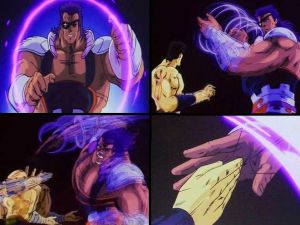Ha no Rin: Difference between revisions
Appearance
Nihongo template automatically puts the romaji first Tag: sourceedit |
No edit summary |
||
| (One intermediate revision by one other user not shown) | |||
| Line 8: | Line 8: | ||
|Image = [[File:Ha no Rin!.jpg|300px|]] | |Image = [[File:Ha no Rin!.jpg|300px|]] | ||
}} | }} | ||
:'''Ha no Rin''' (破の輪; literally “''Ring of Destruction''”) is a ''[[Gento Koken]]'' technique in which the user gathers their ki and shapes it into a circle which they use to fires off a giant beam of purple energy at their desired target. | |||
== Appears in == | == Appears in == | ||
| Line 16: | Line 16: | ||
== Trivia == | == Trivia == | ||
* ''Ring of Destruction'' was also the export title of Capcom's 1995 wrestling game ''Super Muscle Bomber'', which featured promotional artwork by Tetsuo Hara. It is unknown if the title was a deliberate reference or just a coincidence. | * ''Ring of Destruction'' was also the export title of Capcom's 1995 wrestling game ''Super Muscle Bomber'', which featured promotional artwork by Tetsuo Hara. It is unknown if the title was a deliberate reference to this technique or just a coincidence. | ||
[[Category:Gento Ko Ken techniques]] | [[Category:Gento Ko Ken techniques]] | ||
Latest revision as of 05:08, 14 December 2021
| Ha no Rin | |
|---|---|
 | |
| Name | |
| Kanji | 破の輪 |
| Romaji | Ha no Rin |
| English | Ring of Destruction |
| Data | |
| School | Gento Kō Ken |
- Ha no Rin (破の輪; literally “Ring of Destruction”) is a Gento Koken technique in which the user gathers their ki and shapes it into a circle which they use to fires off a giant beam of purple energy at their desired target.
Appears in
[edit | edit source]- Original Manga
Chapter 148, Anime #114
Trivia
[edit | edit source]- Ring of Destruction was also the export title of Capcom's 1995 wrestling game Super Muscle Bomber, which featured promotional artwork by Tetsuo Hara. It is unknown if the title was a deliberate reference to this technique or just a coincidence.